A whole house fan installation can help reduce your energy bills. Some calculations claim that one of these systems can have an operating cost as little as 1/5th as much as cooling your home with an air conditioner. While these systems excel at night time by drawing in the cooler evening air, most of us are not home during the day which makes for a perfect use of a whole house fan from dinner time to bedtime. The one draw back to these systems is that they are noisy. The fan move a lot of air and the blade cutting the air created the noise.
I was able to install the system on my own and my system rated higher on the difficulty scale as I had several unknown surprises that added to the job. If this job is not your cup of tea, please contact me for a quality referral to a local contractor who can install a system for you.
For those of you that know me on a more personal level, you have seen some to the projects I have taken on at my last home and now I continue at my new home. I grew up with a father who was a MacGyver before there was a TV series and there are some project I like to take on…….just because I can. My construction experience has given me the opportunity to decide which projects I would like to tackle.
I marched down to Home Depot to pick a whole house fan to help cool off the Attic and home in the early evening. Simi Valley tends to cool off at night so running the AC is really not necessary and a whole house fan really helps this process. I did get some help from a few A/C contractors Fort Myers.
The hall way at the top of my stairs really did not have many choices for a location. Support for the roof , natural gas for the fireplace, ducting and electrical circuits all added to the challenge of finding a suitable location.
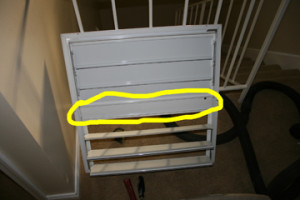
The HVAC ducting became the main challenge, it had to be moved. Like most old homes when you start working on older items the job will become bigger than originally planned. I wanted to replace a 10 foot section of ducting, but it was old and in bad shape so I ended up replacing all the ducting for three bedrooms.The instructions on/in the box for the fan installation were clear, however I found a mechanical inconsistency in the design. There are two ways to install the fan. The ceiling joists can be cut and blocking can be added to create a square open plenum. The fan is designed so you do not have to cut the joists and you can install the fan with the center joist left in place (See Picture 1). This second installation did not show the construction of a plenum. I believe the installation of a plenum is important to keep the air flow coming from the living space and not having the air from the attic just recirculating. Also the absence of the plenum would make it difficult for the louvers to open when you turn on the fan. Last the blown in insulation that covers most of my attic is really unmanageable to not install a plenum.
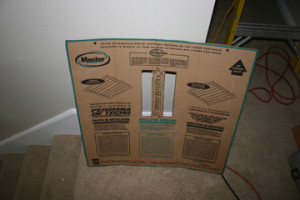
The outside of the box has a template to line up and cut the hole if your are going to leave the center joist in as I did. Two rectangular holes are cut from the box with a strip of box left in the center (See Picture 2). You need to locate the joist where you plan to install the fan and cut the drywall from the area about the size of the cardboard cut outs on the box. Lining up the cardboard strip on the box with the joist the outline of the hole for the plenum can be traced on the ceiling.
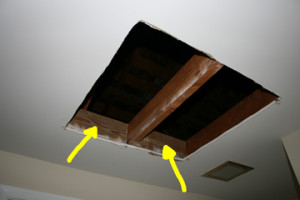
Carefully cut out the drywall. Chances are that the cut will not span from joist to joist. This is okay as blocking can be added to create a solid area to attach the screw for the louvered cover. Before working on the blocking and plenum needs to be created so the fan is drawing air from the living space only. The picture with the two yellow arrows shows how 2×6 fillers where nailed between the joist (See Picture 3).
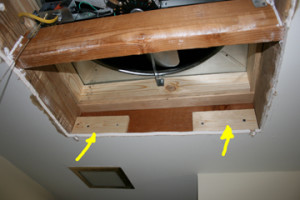
The kit includes drywall anchors, but blocking really is the best way to approach this. Depending on how big the gap is 1 x 4 pine will work just fine. (See Picture 4)

Again my concern for a good plenum to make sure the air flow is coming completely from the house and not pulling attic air, caused me to caulk the cracks. This attic also has blow-in insulation that is very messy, so this will also help keep the mess in the attic. (See Picture 5)
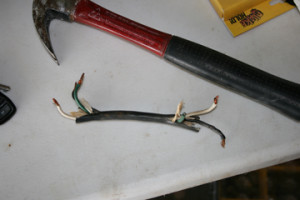
This is a great picture of a typical home repair gone bad. One of the prior home owners spliced into a circuit in the attic and used this black outdoor braided wire for a dangerous splice and laid the handy-work in the blown-in insulation. (See Picture 6)
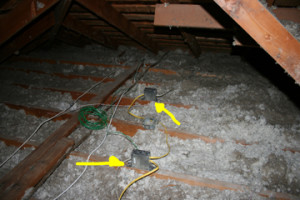
Cleaning up and taking out the splice I installed two J-boxes and added the fan power to this circuit. (See Picture 7)
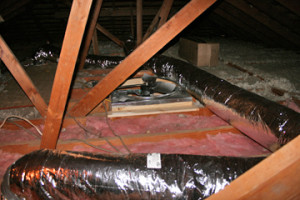
Here is a picture of the work. The attic was probably about 130 degrees and the ducting really added time to this job. The new ducts along with the new location of the fan are visible. (See Picture 8)
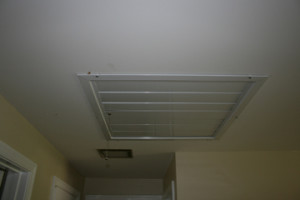
The grill cover is fitted in the hole and fasten with screws through the drywall and into the backing (See Picture 9).
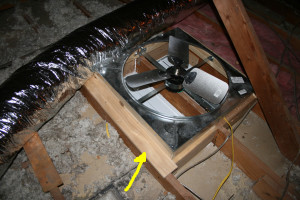
To ensure that I had a decent plenum to pull all the air from the house and not have the fan just recirculate the air in the attic. I sealed up all the gaps between the frame and the fan using 1 x 3 pine. (See Picture 10)
This was a harder project and with the temperatures that attics can reach during the summer, this job is not for everyone. Even though you can save quite a bit of money in handling the installation on your own, this job requires experience working with electricity, and power tools. This project should be approached with caution.
It is very typical for the outside air temperature to cool off quickly in Simi Valley as the sun goes down. A whole house fan creates the oppotunity to draw the fresh cool outside air in and blow the hot air out through the attic. This eliminates the need to run the AC and reduce the cost of the electric bill.
This project is provided as a service. The information in this article is intended to simplify jobs around the house. Tools, products, materials, techniques, building codes and local regulations change; therefore, this website, it’s owners, authors or editors assumes no liability for omissions, errors or the outcome of any project. The reader must always exercise reasonable caution, follow current codes and regulations that may apply, and is urged to consult with a licensed professional if in doubt about any procedures.

What model fan did you purchase? Most of the units I’ve seen require the joists to be cut and I would rather avoid that.